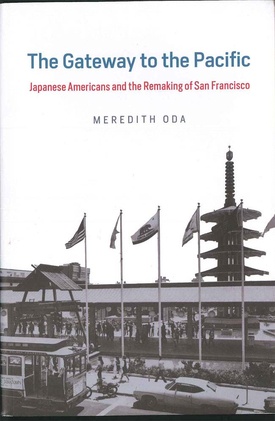My first visit to San Francisco’s Japantown occurred in May 1974. It came about when I, along with two colleagues in the Japanese American Project of the Oral History Program at California State University, Fullerton, Betty Mitson and Ron Larson, journeyed to the City by the Bay to conduct tape-recorded interviews with the prominent Communist couple Karl Yoneda (1906-1999) and Elaine Black Yoneda (1906-1988). After interviewing them for two days, the Yonedas kindly invited us to be their dinner guests in Japantown at a restaurant located in the spectacular Japanese Cultural and Trade Center. Its opening nearly six years earlier on March 28, 1968, climaxed a decade of post-World War II urban redevelopment, eviction and gentrification of San Francisco’s blighted multiethnic Western Addition neighborhood that had formerly served as the residential and commercial home for two-thirds of the city’s more than 5,000 Japanese Americans.
During the drive to this destination and throughout the sumptuous meal we enjoyed there together, the Yonedas evinced mixed feelings about this facility. However, it was not until I read Meredith Oda’s extraordinary and very complex volume of urban, Japanese American, and transpacific history that I began to grasp the reasons for their ambivalent outlook.
On the one hand, they likely appreciated that the Japanese Cultural and Trade Center epitomized an elevated identity for Nikkei in San Francisco and in the postwar Pacific World as a rejuvenated Japan came into vogue, and respected that accomplished Japanese Americans like bilingual, Japan-born, Honolulu-based Masayuki Tokioka was its developer, while Minoru Yamasaki and Noboru Nakamura, were its architects and interpreters of Japanese design.
On the other hand, the Yonedas most probably were chagrined that the Japanese Cultural and Trade Center symbolized the transformation of Japantown into a commercialized, tourist-oriented area that was representative more of being Japanese in character rather than Japanese American, a place that, in the words of historian Mari Yoshihara of the University of Hawai‘i at Mānoa, “was increasingly focused on the promotion of trade with Japan rather than on the livelihood of Japanese Americans who had made the city their home before and after wartime incarceration.”
The Yonedas also were no doubt dismayed and disappointed by the fact that Japanese American leaders, in promoting redevelopment projects like the Japanese center, had distanced themselves from their former alliances with African Americans and other Western Addition ethnic groups who had opposed these same projects. In short, Japanese American advocates had established themselves, as observed by historian Abigail Markwyn of Wisconsin’s Carroll University, as a privileged model minority group by “facilitating the white embrace of Japanese town as a symbol of the city’s cosmopolitanism and transpacific urbanity.” Instead of pursuing civil justice and diverse democratic values, these Nikkei leaders, observes Yoshihara, chose to “embrace both the official goals of urban progress and relations with Japan.”
There is so much more to The Gateway to the Pacific: Japanese Americans and the Remaking of San Francisco than can be conveyed in a brief, personal, and impressionistic review such as this one. This ambitiously conceived, deeply researched, clearly organized and pellucidly authored book by Oda, a University of Nevada, Reno historian, and a rising star in Asian American and Japanese American studies, deserves to be read by a large audience, but perhaps most especially by Bay Area Japanese Americans.
THE GATEWAY TO THE PACIFIC: JAPANESE AMERICANS AND THE REMAKING OF SAN FRANCISCO
By Meredith Oda
(Chicago: University of Chicago Press, 2019, 304 pp., $35, paperback)
*This article was originally published on the Nichi Bei Weekly on January 1, 2021.
© 2021 Arthur A. Hansen / Nichi Bei Weekly








